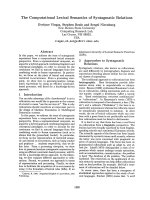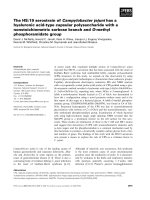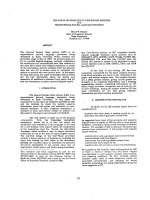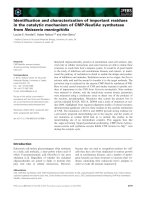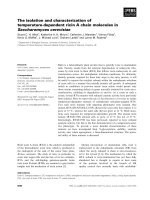Báo cáo khoa học: "THE SYNTAX AND SEMANTICS OF USER-DEFINED MODIFIERS IN A TRANSPORTABLE NATURAL LANGUAGE PROCESSOR" pot
Bạn đang xem bản rút gọn của tài liệu. Xem và tải ngay bản đầy đủ của tài liệu tại đây (382.99 KB, 5 trang )
THE SYNTAX AND SEMANTICS OF USER-DEFINED MODIFIERS
IN A
TRANSPORTABLE NATURAL LANGUAGE PROCESSOR
Bruce W. Ballard
Dept. of Computer Science
Duke University
Durham, N.C. 27708
ABSTRACT
The Layered Domain Class system
(LDC)
is an
experimental natural language processor being
developed at Duke University which reached the
prototype stage in May of 1983. Its primary goals are
(I) to provide English-language retrieval capabilities
for structured but unnormaUzed data files created by
the user, (2) to allow very complex semantics, in terms
of the information directly available from the physical
data file; and (3) to enable users to customize the
system to operate with new types of data. In this paper
we shall discuss (a) the types of modifiers LDC provides
for; (b) how information about the syntax and
semantics of modifmrs is obtained from users; and (c)
how this information is used to process English inputs.
I INTRODUCTION
The Layered Domain Class system (LDC) is an
experimental natural language processor being
developed at Duke .University. In this paper we
concentrate on the typ.~s of modifiers provided by LDC
and the methods by which the system acquires
information about the syntax and semantics of user-
defined modifiers. A more complete description is
available in [4,5], and further details on matters not
discussed in this paper can be found in [1,2,6,8,9].
The LDC system is made up of two primary
components. First, the
Ic'nowledge aeTui.~i2ion
component, whose job is to find out about the
vocabulary and semantics of the language to be used
for a new domain, then inquire about the composition
of the underlying input file. Second, the User-Phase
Processor,
which enables a user to obtain statistical
reductions on his or her data by typed English inputs.
The top-level design of the User-Phase processor
involves a linear sequence of modules for
scavtvtir~g
the
input and looking up each token in the dictionary;
pars/rig the scanned input to determine its syntactic
structure;
translatiort
of the parsed input into an
appropriate formal query; and finally query
processing.
This research has been supported in part by the
National Science Foundation, Grants MCS-81-16607 and
IST-83-01994; in part by the National Library of
Medicine, Grant LM-07003; and in part by the Air Force
Office of Scientific Research, Grant 81-0221.
The User-Phrase portion of LDC resembles familiar
natural language database query systems such as
INTELLECT, JETS. LADDER, LUNAR. PHLIQA, PLANES, REL,
RENDEZVOUS, TQA, and USL (see [10-23]) while the
overall LDC system is similar in its objectives to more
recent systems such as ASK, CONSUL, IRUS, and TEAM
(see [24-319.
At the time of this writing, LDC has been
completely customized for two fairly complex domains.
from which examples are drawn in the remainder of the
paper, and several simpler ones. The complex domains
are
a 2~al gTz, des domain, giving course grades for
students in an academic department, and a bu~di~tg
~rgsvtizatiovt
domain, containing information on the
floors, wings, corridors, occupants, and so forth for one
or more buildings. Among the simpler domains LDC has
been customized for are files giving employee
information and stock market quotations.
II MODIFIER TYPES PROVIDED FOR
As shown in [4]. LDC handles inputs about as
complicated as
students who were given a passing grade by an
instructor Jim took a graduate course from
As suggested here, most of the syntactic and semantic
sophistication of inputs to LDC are due to noun phrase
modifiers, including a fairly broad coverage of relative
clauses. For example, if LDC is told that "students take
courses from instructors", it will accept such relative
clause forms as
students who took a graduate course from Trivedi
courses Sarah took from Rogers
instructors Jim took a graduate course from
courses that were taken by Jim
students who did not take a course from Rosenberg
We summarize the modifier types distinguished by LDC
in Table i. which is divided into four parts roughly
corresponding to pre-norninal, nominal, post-nominal,
and negating modifiers. We have included several
modifier types, most of them anaphorie, which are
processed syntactically, and methods for whose
semantic processing are being implemented along the
lines suggested in [7].
52
Most of the names we give to modifier types are self-
explanatory, but the reader will notice that we have
chosen to categorize verbs, based upon their
semantics, as tr~Isial verbs,
irrtplied para~ter
verbs;
and
operational
verbs. "Trivial" verbs, which involve no
semantics to speak of, can be roughly paraphrased as
"be associated with". For example, students who
take a
certain course are precisely those students
associated
~ith the database records related to the course.
"Implied parameter" verbs can be paraphrased as a
longer "trivial" verb phrase by adding a parameter and
requisite noise words for syntactic acceptability. For
example, students who fai/a course are those students
who
rrmlce a grade of F in
the course. Finally,
"operational" verbs require an operation to be
performed on one or more of its noun phrase
arguments, rather than simply asking for a comparison
of its noun phrase referent(s) against values in
specified fields of the physical data file. For example,
the students who
oz~tscure
Jim are precisely those
students who
Trtake a grade h~gher than the grade of
Jirm At present, prepositions are treated semantically
as trivial verbs, so that "students in AI" is interpreted
as "students associated with records related to the AI
course".
Table 1 - Modifier Types Available in LDC
Modifier Type
Example Usage
Syntax
Implemented
Semantics
Implemented
Ordinal the second floor yes yes
3uperlative the largest office yes yes
Anaphoric better students
Comparative more desirable instructors yes no
Adjective the large rooms
classes that were small yes yes
Anaphoric
Argument-Taking Adjective adjacent offices yes no
Anaphoric
Implied-Parameter Verb failing students yes no
Noun Modifier conference rooms yes yes
Subtype offices yes yes
Argument-Taking Noun classmates of Jim
Jim's classmates yes yes
Anaphoric
Argument-Taking Noun the best classmate yes no
Prepositional
Phrase
students
in CPS215 yes (yes)
Comparative Phrase students better than Jim
a higher grade than a C yes yes
Trivial instructors who teach AI
Verb Phrase students who took AI from Smith yes yes
Implied-Parameter
Verb Phrase students who failed AI yes yes
Operational
Verb Phrase students who outscored Jim yes yes
Argument-Taking Adjective offices adjacent to X-238 yes yes
Negations the non graduate students
(of many sorts) offices not adjacent to X-23B
instructors that did not teach M yes yes
etc.
53
III
KNOWLEDGE ACQUISITION FOR MODIFIERS
The job of the knowledge acquisition module
of LDC, called "Prep" in Figure 1, is to' find out about
(a) the vocabulary of the new domain and (b) the
composition of the physical data file. This paper is
concerned only with vocabulary acquisition, which
occurs in three stages. In Stage 1, Prep asks the user
to name each ent~.ty, or conceptual data item, of the
domain. As each entity name is given, Prep asks for
several simple kinds of information, as in
ENTITY NAME? section
SYNONYMS: class
TYPE (PERSON, NUMBER, LIST, PATTERN, NONE)?
pattern
GIVE 2 OR 3 EXAMPLE NAMES: epsSl.12, ee34.1
NOUN SUBTYPES: none
ADJECTIVES: large, small
NOUN MODIFIERS: none
HIGHER LEVEL ENTITIES: class
LOWER LEVEL ENTITIES: student, instructor
MULTIPLE ENTITY? yes
ORDERED ENTITY? yes
Prep next determines the case structure of verbs
having the given entity as surface subject, as in
ACQUIRING VERBS FOR STUDENT:
A STUDENT CAN pass a course
fail a course
take a course from an instructor
make a grade from an instructor
make a grade in a course
In Stage 2, Prep learns the
rnorhological variants
of
words not known
to
it, e.g. plurals for nouns,
comparative and superlative forms for adjectives, and
past tense and participle forms for verbs. For example,
PAST-TENSE VERB ACQUISITION
PLEASE GIVE CORRECTED FORMS, OR HIT RETURN
FAIL FAILED >
BITE BITED
> bit
TRY
TRIED
>
In Stage 3, Prep acquires the semantics of adjectives,
verbs, and other modifier types, based upon the
following principles.
1. Systems which attempt to acquire complex
semantics from relatively untrained users had
better restrict the class of the domains they seek
to provide an interface to.
For this reason, LDC restricts itself to a class of
domains [1] in which the important relationships
among domain entities involve hierarchical
decompositions.
2. There need not be any correlation between the type
of modifier being defined and the way in which its
rr~eaTt/rtg relates to the underlying data file.
For this reason, Prep acquires the meanings of all
user-defined modifiers in the same manner by
providing such primitives as id, the identity function;
va2, which retrieves a specified field of a record; vzzern,
which returns the size of its argument, which is
assumed to be a set; sum, which returns the sum of '.'-s
list of inputs; aug, which returns the average of its list
of inputs; and pct, which returns the percentage of its
list of boolean arguments which are true. Other user-
defined adjectives may also be used. Thus, a "desirable
instructor" might be defined as an instructor who gave
a good grade to more than half his students, where a
"good grade" is defined as a grade of B or above. These
two adjectives may be specified as shown below.
ACQUIRING SEMANTICS FOR DESIRABLE INSTRUCTOR
PRIMARY? section
TARGET? grade
PATH IS: GRADE /STUDENT /SECTION-
FUNCTIONS? good /id /pet
PREDICATE? > 50
ACQUIRING SEMANTICS FOR GOOD GRADE
PRIMARY? grade
TARGET? grade
PATH
IS:
GRADE
FUNCTIONS? val
PREDICATE? >= B
As shown here, Prep requests three pieces of
information for each adjective-entity pair, namely (1)
the pv-/.rn.ary (highest-level)
and
~c~rget [lowest-level)
entities needed to specify the desired adjective
meaning; (2) a list of furtcticvts corresponding to the
arcs on the path from the primary to the target nodes;
and finally (3) a pred/cate to be applied to the
numerical value obtained from the series of function
calls just acquired.
IV UTILIZATION OF THE INFORMATION ACQUIRED
DURING PREPROCESSING
As shown in Figure i, the English-language
processor of LDC achieves domain independence by
restricting itself to (a) a domain-independent.
linguistically-motivated phrase-structure grammar [6]
and (b) and the domain-specific files produced by the
knowledge acquisition module.
The simplest file is the
pattern
file, which
captures the morphology of domain-specific proper
nouns, e.g. the entity type "room" may have values
such as X-238 and A-22, or "letter, dash. digits". This
information frees us from having to store all possible
field values in the dictionary, as some systems do, or to
make reference to the physical data file when new data
values are typed by the user, as other systems do.
The domain-specific d/ctlon~ry file contains
some standard terms (articles, ordinals, etc.) and also
both root words and inflections for terms acquired
from the user. The sample dictionary entry
(longest Superl long (nt meeting week))
says that
"longest" is
the
superlative form
of the
adjective "long", and may occur in noun phrases whose
'head noun refers to entities of type meeting or week.
By having this information in the dictionary, the parser
can perform "local" compatibility checks to assure the
54
I User
User .,
> PREP
Pattern Dictionary Compat
File
///
//
SCANNER ~I PARSER
File
f
*1 TRANSLATOR
Augmented
Phrase-Structured
Grammar
Macro
File
\
) RETRIEVAL i
T
Text-Edited
Data
File
Figure 1 - Overview of LDC
integrity of a noun phrase being built up, i.e. to assure
all words in the phrase can go together on non-
syntactic grounds. This aids in disambiguation, yet
avoids expensive interaction with a subsequent
semantics module.
related to negation Interestingly, most meaningful
interpretations of phrases containing "non" or "not"
can be obtained by inserting the retrieval r2.odule's Not
command at an appropriate point in the macro body
for the modifier in question. For example,
An opportunity to perform "non-local"
compatibility checking is provided for by the
eompat
file, which tells (a) the case structure of each verb, i.e.
which prepositions may occur and which entity types
may fill each noun phrase "slot", and (b) which pairs of
entity types may be linked by each preposition. The
former information will have been acquired directly
from the user, while the latter is predicted by
heuristics based upon the sorts of conceptual
relationships that can occur in the "layered" domains
of interest [1].
Finally, the macro file contains the meanings
of modifiers, roughly in the form in which they were
acquired using the specification language discussed in
the previous section. Although this required us to
formulate our own retrieval query language [3], having
complex modifier meanings directly exceutable by the
retrieval module enables us to avoid many of the
problems typically arising in the translation from parse
structures to formal retrieval queries• Furthermore,
some modifier meanings can be
derived
by the system
from the meanings of other modifiers, rather than
separately acquired from the user• For example, if the
meaning of the adjective "large" has been given by the
user, the system automatically processes "largest" and
"larger than " by appropriately interpreting the
macro body for "large".
A partially unsolved problem in macro
processing involves the resolution of scope ambiguities
students who were not failed by Rosenberg
might or might not be intended to include students
who did not take a course from Rosenberg. The
retrieval query commands generated by the positive
usage of "fail", as in
students that Rosenberg failed
would be the sequence
instructor Rosenberg;
student -> fail
so the question is whether to introduce "not" at the
phrase level
not iinstructor = Rosenberg;
student -> fail~
or instead at the verb level
instructor = Rosenberg;
not ~student -> fail]
Our current system takes the literal reading, and thus
generates the first interpretation given• The example
points out the close relationship between negation
scope and the important problem of "presupposition",
in that the user may be interested only in students who
had a chance to be failed•
55
REFERENCES
I. BaUard, B. A "Domain Class" approach to transportable
natural language processing. Cogn~tio~ g~td /Yrczin
Theory, 5 (1982), 3, pp. 269-287.
Ballard, B. and Lusth, J. An English-language processing
system that "learns" about new domains.
AF~PS N¢~on~
Gomputer Conference, 1983. pp. 39-46.
Ballard, B. and Lusth, J. The design of DOMINO: a
knowledge-based information retrieval processor for
office enviroments. Tech. Report CS-1984-2, Dept. of
Computer Science, Duke University, February 1984.
Ballard, B., Lusth, J. and Tinkham, N. LDC-I: a
transportable, knowledge-based natural language
processor for office environments.
ACM Tt'~ns. o~ Off~ce
/~-mah~ ~ystoma, 2 (1984), 1, pp. 1-25.
BaUard, B., Lusth, J. and Tinkham, N. Transportable
English language processing for office environments.
AF~' Nat~mw~ O~m~uter Conference, 1984, to appear in
the proceedings.
Ballard, B. and Tinkham, N. A phrase-structured
grammatical formalism for transportable natural
language processing,
llm~r.
J.
Cow~p~t~zt~na~ L~n~ist~cs,
to appear.
Biermann, A. and Ballard, B. Toward natural language
computation.
Am~r. ~. Com~ut=~mu=l ~g=iet~cs, 6
(1980), 2,
pp. 71-86.
Lusth, J. Conceptual Information Retrieval for Improved
Natural Language Processing (Master's Thesis). Dept. of
Computer Science, Duke University, February 1984.
Lusth, J. and Ballard, B. Knowledge acquisition for a
natural language processor. Cue,'ere*we o~ .4~t~-ieJ
.~tetH@e~ws,
Oakland University, Rochester, Michigan,
April 1983, to appear in the proceedings.
I0. Bronnenberg, W., Landsbergen, S., Scha, R.,
Schoenmakers, W. and van Utteren, E. pHLIQA-1, a
question-answering system for data-base consultation in
natural English. /Wt~s tecA, Roy. 38 (1978-79), pp.
229-239 and 269-284.
11. Codd, T. Seven steps to RENDEZVOUS with the casual
user. [n Do2~
Base M¢m,o, gem, en¢,
J. Kimbie and K.
Koffeman (Eds.), North-Holland, 1974.
12. Codd, T. RENDEZVOUS Version I: Aa experimental
English-language query formulation system for casual
users of relational data bases. IBM Research Report
RJ2144, San Jose, Ca., 1978.
13. Finin, T., Goodman, B. and Tennant, H. JETS: achieving
completeness through coverage and closure. Int. J. Conf.
on Art~j~/n~e/~igence, 1979, pp. 275-281.
14. Harris, L. User-oriented data base query with the Robot
natural language system.
Int.
J. M~n-M~ch~ne ~dies, 9
(1977), pp. 697-713.
15. Harris, L. The ROBOT system: natural language
processing applied to data base query.
ACM Nct~ion~t
C~rnference, 1978, pp. 165-172.
16. Hendrix, G. Human engineering for applied natural
language processing. /n~. $. Co~f. o~ .4~t~j~c~a~
~¢tott@jev~e,
1977, pp. 183-191.
2.
3.
4.
5.
8.
7.
8.
9.
17. Hendrix, G., Sacerdoti, E., Sagalowicz, D. and Slocum, J.
Developing a natural language interface to complex data.
ACM Tr(uts. on D=t~bsse ~l/stsrrts, 3 (1978), 2, pp. 105-147.
18. Lehmann, H. Interpretation of natural language in an
information system.
IBM $. _N~s. Des. 22
(1978), 5, pp.
560-571.
19.
Plath, W. REQUEST: a natural language question-
answering system.
IBM J: ~s. Deo., 20
(1976), 4, pp. 326-
335.
20. Thompson, F. and Thompson, B. Practical natural
language processing: the gEL system as prototype. In
Ad~vtces ~t Com~ters, Vol. 3, M. Rubinoff and M. Yovits,
Eds., Academic Press, 1975.
21. Waltz, D. An English language question answering system
for a large relational database.
Cowzm. ACM
21 (1978), 7,
pp. 526-539.
22. Woods, W. Semantics and quantification in natural
language question answering.
In Advances ~,n Computers,
Vol. 17, M. Yovits, Ed., Academic Press, 1978.
23.
Woods, W., Kaplan, R. and Nash-Webber, B. The
Lunar
3L'iencos Natural Lar~w, ge ~tfov~rn~t~n ~Jstsm:
]~¢rrt. Report
2378, Bolt,
Beranek and Newman,
Cambridge, Mass., 1972.
24.
Ginsparg, J. A robust portable natural language data
base interface. Cmlf. on Ap'1)lied Nc~t~ral L~znguage
Processing, Santa Munica, Ca., 1983, pp. 25-30.
25.
Grosz, B. TEAM: A transportable natural language
interface system. Omf. o~ ~plied Nut, rat L~-tLags
Processiz~,
Santa Monica, Ca., 1983, pp. 39-45.
28. Haas, N. and Hendrix, G. An approach to acquiring and
applying knowledge.
.~rst N;t. Cor~. o~
.~tell~qTence,
Stanford univ., Palo Alto, Ca., 1980, pp. 235-
239.
27. Hendrix, G. and Lewis, W. Transportable natural-language
interfaces to databases.
Proc. 19th A~z~t Meet~w of the
ACL, Stanford Univ., 1981, pp. 159-165.
28. Mark, W. Representation and inference in the Consul
system.
~t.
Jo'i, nt Conf. on ~ct#,f~c'i~l
[nteU{gence,
1981.
29. Thompson, B. and Thompson, F. Introducing ASK, a
simple knowledgeable system.
Co~I. on AppLied Natu~zt
L~tg1~zge i~rocsssing,
Santa Monica, Ca., 1983, pp. 17-24.
30. Thompson, F. and Thompson, B. Shifting to a higher gear
in a natural language system. Na~-na~ CornF~ter
Coexistence, 1981, 657-662.
31. WUczynski, D. Knowledge acquisition in the Consul
system.
Int.
Jo~,nt Conf. on .4rt~f~c~ /ntsUwence,
1981.
56





